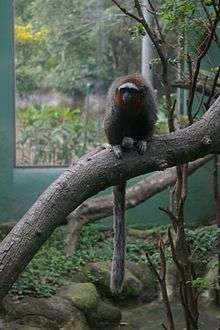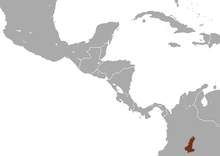Ornate titi
| Ornate titi[1] | |
|---|---|
 | |
| Ornate titi in Cali Zoo. | |
| Scientific classification | |
| Kingdom: | Animalia |
| Phylum: | Chordata |
| Class: | Mammalia |
| Order: | Primates |
| Family: | Pitheciidae |
| Genus: | Callicebus |
| Species: | C. ornatus |
| Binomial name | |
| Callicebus ornatus (Gray, 1866) | |
 | |
| Ornate Titi range | |
The ornate titi (Callicebus ornatus) is a species of titi belonging to the p. moloch group, and is the smallest member of the Pitheciidae family, which also includes uakaris and saki monkeys. As it is a member of this family, it is classified as a type of New World monkey. It is endemic to eastern Colombia, and the only member of the p. moloch group to occur north of the Rios Amazonas/Solimes/Napo axis, living at least 350 km away from the closest other member, the white tailed-titi (Callicebus discolor), which lives in the south of Colombia. It was once classified as the same species as the white-tailed titi, but is now officially recognized as its own species.[3] The ornate titi is also terrestrial.[4]
The ornate titi is present on the IUCN list of endangered species, being recognized as “Vulnerable”, and having a general decrease in population trends.
Description
The ornate titi has a thick, dense, fluffy, coat, with white ears and forehead, and grey hands and feet. The rest of the body is a bright chestnut red, apart from the tail, which is a dark-reddish brown or black, becoming white at the tip, and, similar to most titi species, is longer than its body. Male and female ornate titis do not differentiate significantly in appearance, however, generally, females tend to be larger, with an average male body length of 633 mm, and an average female body length of 752 mm.[5][3]
Ecology
Habitat and threats
The ornate titi lives in the department of Cundinamarca (Medina) north as far as the lower Ro Upa/Ro Meta, and south into the department of Meta, along the base of the Cordillera Oriental and the Sierra de la Macarena to the Ro Guayabero/upper Ro Guaviare. It mainly inhabits the tropic and sub-tropic levels of the forest, generally preferring areas with dense vegetation, such as thickets, tangles, thorny underbrushes and wet or even waterlogged areas.
The ornate titi tends to sleep in vine tangles located on small branches of trees, generally preferring to be at least 15m off of the ground. Like other members of the moloch group, the ornate titi is considered tolerant of seasonal flooding and disturbances within its habitat, and is commonly found living in areas of forest disturbed by humans, in particular thriving on highly disturbed habitats.[6] However, due to the continuous expanding of human settlements and therefore declination of both the size and quality of the ornate titi’s habitat, the presence of the species has become severely fragmented, with the current approximate area of habituated land around 20,000 km a decline of 30% in the last 24 years, and has been listed as Vulnerable by the IUCN since 1994 and is listed on Appendix II of CITES.[4][7]
Decline in habitat has also lead to a change in population, with a recorded population density of 5 individuals/km, and a general decreasing population trend.
Diet and lifestyle
The ornate titi is an omnivore, but its diet is mainly frugivorous, their diet consisting of 70% fruit, 26% leaves, and less than 1% insects, usually with a preference for fruit that is not ripe, or that comes from smaller trees, as they can more efficiently exploit the more concentrated supply. However, they will also eat small (Generally less than 2 cm long) insects, such as moths, butterflies, cocoons, spiders, and ants, and are able to catch flying insects out of the air.
Out of the leaves which make up more than quarter of their diet, the ornate titi tends to prefer small leaves and buds, and during the dry season, their diets will become a lot more vine and bamboo based.
Due to this mainly herbivorous diet, the ornate titi spends a significant portion of the day sleeping. They usually spend around 60% of their time sleeping, which hugely differs from C. discolor, which spends less than 25%.[6]
Feeding patterns
The ornate titi is diurnal, rising early in the morning and remaining awake and active until sunrise, however this depends on the season, due to the change in availability in food, particularly fruit, which tends to only appear in abundance in the warmer months. In contrast, an ornate titi may stay in sleeping site for up to four hours after sunrise in colder months. Usually, a titi's daily activity lasts for around 11.5 hours, with feeding taking up around 2.7 hours.
Their day is typically split into two feeding sessions, one in the morning and one in the evening, with a resting session at around midday. The last few hours of the day are generally spent feeding on leaves.[6]
Predators
The predominant and most important predators of all titis are raptors. Several species of raptor have been observed attacking a titi, including the Guianan crested eagle (Morphnus guianensis) and the Ornate hawk-eagle (Spizaetus ornatus). Tufted capuchins (Cebus apella) have also been observed killing and consuming an ornate titi.[6]
Reproduction and infant behaviour
The ornate titi is monogamous, and their upbringing is entirely paternal, only ever being passed to the mother to be fed.[8] with the birth season being from December to March, with the smallest infants being born in December to January.[9] The average gestation period for an ornate titi is 128 days (4.2) months, and there have been observations that, during lactation, female titis tend to increase the amount of protein in their diet (Primarily by eating more insects).[6]
Conservation
Some conservation efforts within Colombia have been made, since the species occurs in La Macarena National Park and Tinigua National Park, and although some populations have been observed in protected areas, guerilla activity makes it difficult to monitor.[4]
References
| Wikispecies has information related to: Ornate Titi |
- ↑ Groves, C.P. (2005). Wilson, D.E.; Reeder, D.M., eds. Mammal Species of the World: A Taxonomic and Geographic Reference (3rd ed.). Baltimore: Johns Hopkins University Press. p. 145. ISBN 0-801-88221-4. OCLC 62265494.
- ↑ Veiga, L. M. & Palacios, E. (2008). "Callicebus ornatus". IUCN Red List of Threatened Species. Version 2008. International Union for Conservation of Nature. Retrieved 3 January 2009.
- 1 2 "ornatus – Callicebus Database". callicebus.nl. Retrieved 2017-03-04.
- 1 2 3 "Ornate Titi - Callicebus ornatus - Details - Encyclopedia of Life". Encyclopedia of Life. Retrieved 2017-03-04.
- ↑ "Ornate titi monkey videos, photos and facts - Callicebus ornatus". ARKive. Retrieved 2017-03-04.
- 1 2 3 4 5 "Primate Factsheets: Dusky titi (Callicebus moloch) Taxonomy, Morphology, & Ecology". pin.primate.wisc.edu. Retrieved 2017-03-05.
- ↑ "Checklist of CITES species". checklist.cites.org. Retrieved 2017-03-04.
- ↑ "Dusky titi monkeys (Callicebus ornatus)". zocayproject. 2016-04-06. Retrieved 2017-03-22.
- ↑ "CALLICEBUS ORNATUS, AN ENDEMIC COLOMBIAN SPECIES: DEMOGRAPHY, BEHAVIOR AND CONSERVATION (PDF Download Available)". ResearchGate. Retrieved 2017-03-05.
